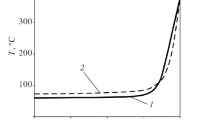Work is devoted to selecting parameters for a hot plastic deformation regime for alloy KhN55MVTs-ID on the basis of analyzing a distribution map for mechanical energy dissipation coefficients. The map is constructed from results of simulation modeling of deformation regimes for alloy samples in the temperature range 900–1140°C and strain rates of 10–3–10 sec–1. Metallographic analysis and a study of the sructure using electron microscopy are used for dissipation coefficients close to extreme values. The expediency of using a map for the process of finding favorable conditions for hot plastic deformation of alloy KhN55MVTs-ID is demonstrated.




Similar content being viewed by others
References
A. S. Oryshchenko, G. P. Karzov, A. S. Kudryavtsev, Yu. M. Trapeznikov, D. A. Artem’eva, and K. A. Okhapkin, RF Patent2546587 S2, Nickel-base heat-resistant alloy, Claim 07.09.2013, Publ. 03.10.15, Bull. No. 7.
V. K. Barakhtin, N. R. Vargasov, and A. I. Rudskoi, “Modification of thermomechanical treatment for rail steel by means of a map of the process,” Materialovedenie, No. 6, 8–14 (2015).
Y. V. R. K. Prasad and S. Sasidhara, Hot Working Guide. A Compendium of Processing Maps, Department of Metallurgy Indian Institute of Science, Bangalore (2004).
N. R. Vargasov and V.V. Rybin, “Optimization of temperature and rate for plastic deformation regimes according to a mechanical energy dissipation criterion,” Metalloved. Term. Obrab. Metallov., No. 9, 52–56 (1999).
Yu. I. Rybin and A. I. Rudskoi, Mathematical Modeling and Planning of Production Processes for Metal Forming [in Russian], SPbGPU, St. Petersburg (2004).
A. S. Oryshchenko, V. A. Malyshevskii, B. K. Barakhtin, N. R. Vargasov, and A. M. Nemets, “Procedural behavior of plastothermal tests for structural metals and alloys,” in: Handbook for Use of TsKP FGUP TsNII KM Prometei Equipment “Composition, Structure and Properties of Functional and Structural Materials,” [in Russian], Izd. FGUP KM Prometei, St. Petersburg (2010).
V. A. Malyshevskii, E. I. Khlusova, and B. K. Barakhtin, “Structural and mechanical state of prospective FCC alloys under hot plastic deformation conditions,” Vopr. Metarialovedeniya, No. 4(64), 7–20 (2010).
B. K. Barakhtin, N. R. Vargasov, A. M. Nemets, and E. I. Khlusova, “Selection of thermomechanical treatment regime for steels and alloys based on systematic analysis of the structure and simulation modeling,” Fiz. Mekhan. Materialov., 12, No. 1, 30–42 (2011).
B. K. Barakhtin and A. M. Nemets, Metals and Alloys. Analysis and Study. Physico-Analytical Methods for Studying Metals and Alloys. Nonmetallic Inclusions: Handbook [in Russian], NPO Professional, St. Petersburg (2006).
B. K. Barakhtin, “Features of polyscale trasfromation in structural steels and alloys under hot conversion conditions,” Coll. Physicochemical Aspects of Studying Clusters, Nanostructures, and Nano-Materials, Tver’ Gos. Univ., Tver, No. 6, 29–40 (2014).
A. D. Kashtanov, S. N. Petrov, A. S. Kudryavtsev, K. A. Okhapkin, and D. A. Gruzdev, “Analysis of reasons for crack formation during hot plastic deformation of alloy grade KhN55MVTs-ID,” Vopr. Materialoved., No. 4(84), 17–22 (2015).
G. P. Karzov, A. D. Kashtanov, A. S. Kudryavtsev, K. A. Okhapkin, and D. A. Gruzdev, “Effect of chemical inhomogeneity on “hot” mechanical properties of alloy KhN55MVTs-ID and increase in adaptability during thermal deformation action,” Vopr. Materialoved., No. 4(84), 23–28 (2015).
A. I. Rudskoi, N. R. Vargasov, and B. K. Barakhtin, Thermoplastic Deformation of Metals [in Russian], Izd. Politekh. Univ., St. Petersburg (2018).
K. A. Okhapkin, A. S. Kudryavtsev, D. A. Gruzdev, and G. K. Rerikh, “Analysis of physicomathematical model and development of recommendations for a large scale forging scheme for alloy grade KhN55MVTs-ID,” Nauch-Tekhn. Vedom. Sankt-Peter. Gos. Politekh. Univ, No. 1(238), 122–128 (2016).
Author information
Authors and Affiliations
Corresponding author
Additional information
Translated from Metallurg, Vol. 64, No. 7, pp. 91–96, July, 2020.
Rights and permissions
About this article
Cite this article
Barakhtin, B.K., Petrov, S.N., Okhapkin, K.A. et al. Selection of Hot Plastic Deformation Regimes for Large Workpieces According to Mechanical Energy Distribution Criteria. Metallurgist 64, 709–715 (2020). https://doi.org/10.1007/s11015-020-01047-z
Received:
Published:
Issue Date:
DOI: https://doi.org/10.1007/s11015-020-01047-z




